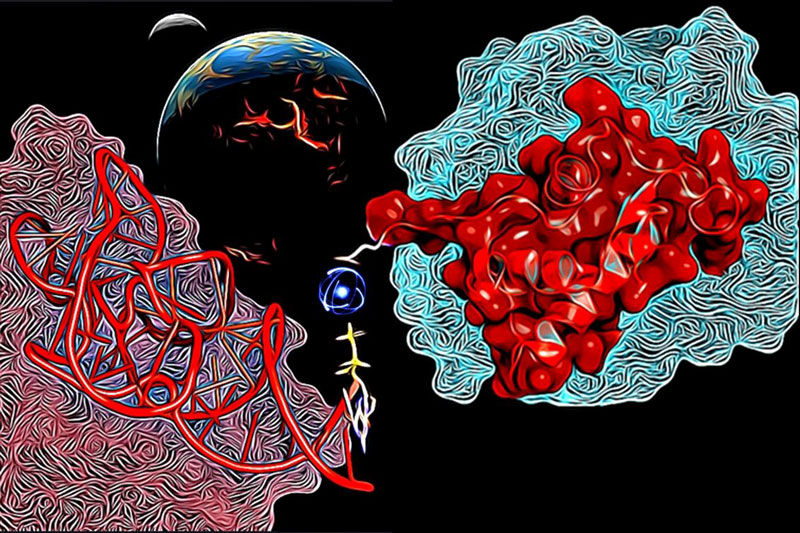RNA-peptide/protein interactions have been important to life since its earliest forms, from even before the last universal common ancestor (LUCA). However, the ancient molecular mechanisms behind this key biological interaction have remained enigmatic because extant RNA-protein interactions rely heavily on positively charged and aromatic amino acids that were absent or heavily under-represented in the early pre-LUCA evolutionary period.

Figure: An illustrative representation of RNA-protein interaction via metal ions (credit: Valerio Guido Giacobelli)
A multidisciplinary team of researchers supported by an HFSP grant performed a study in which an RNA-binding protein domain was re-engineered in the absence of cationic and aromatic amino acids. The team identified an RNA-binding variant of the ribosomal uL11 C-terminal from a ~1010 library of partially randomized sequences (all composed of 10 prebiotically plausible canonical amino acids) using mRNA display. The selected variant binds to the cognate RNA with a similar overall affinity to its modern-day version, even though it is less structured in the unbound form. The profile of the wild-type and mutant complex stabilities along with MD simulations uncovers qualitative differences in the interaction modes. The ancient uL11 domain uses ion bridging interactions between the RNA sugar-phosphate backbone and glutamic acid residues as an alternative source of stabilization. The lack of aromatic/basic residues may have been, therefore, compensated by acidic residues plus metal ions.
In addition, the same team of researchers recently published a review perspectives article that highlights how proteins and nucleic acids (molecules like DNA and RNA) worked together during the origins of life. Their model is broken down into five critical stages of emergence. In the earliest stages, the ancestors of proteins – not nucleic acids – dominate. This is because, the authors argue, the building blocks to make proteins, called amino acids, were surprisingly abundant on ancient Earth and meteorites. Moreover, they can easily combine to make sequences (called peptides) without outside help. On the other hand, the building blocks to make RNA, called nucleotides, were very rare and tricky to string together. Later on, peptides helped RNA by churning out its building blocks, protecting it, and stringing it together, whilst, vice versa, RNA helped peptides by giving them a replicating platform to which they could attach making their synthesis more efficient. The authors end their piece thusly: "Models that try to assert the preeminence of one biomolecule type over others during the Origin of Life will probably prove incorrect in the long run. Like people, when different types of biomolecules work together, amazing things can happen."
Both articles bring together expertise and lines of evidence from diverse areas of research, including molecular biology, bioinformatics, geochemistry, biophysics, and astrobiology - a collaboration that was only made possible by the HFSP grant that brought these researchers together.
|
HFSP award information Research Grant - Early Career (RGY0074/2019): Exploration of the structure/function space of prebiotic to biological proteins Principal investigator: Klara Hlouchova, Charles University, Prague, Czech Republic |


































